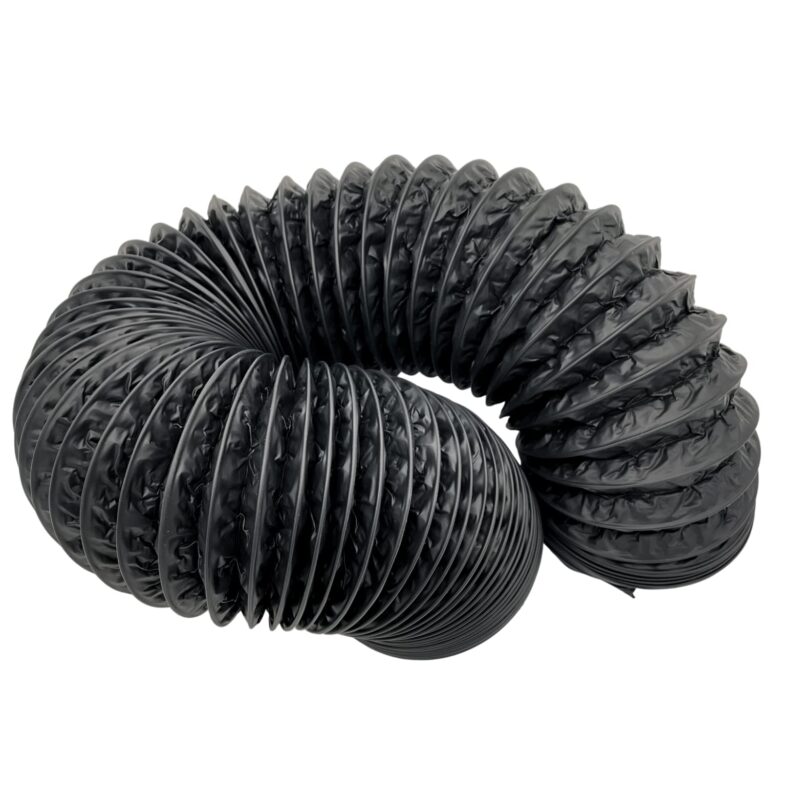Using a carbon filter in an indoor growing setup is essential for odor control and maintaining air quality. The choice of ducting to connect with your carbon filter can impact the efficiency of odor elimination, the durability of the system, and noise levels. Here’s how each type of ducting aligns with the use of a carbon filter in an indoor growing environment:
1. Foil Ducting
Benefits of Foil Ducting:
- Cost-Effective: It’s the most budget-friendly option, suitable for growers looking to minimize expenses.
- Flexible: Its flexibility allows for easy installation and routing in confined spaces.
Drawbacks of Foil Ducting:
- Durability: Prone to tears and punctures, which can compromise the seal and efficiency of the carbon filter system.
- Noise: Does not provide any sound dampening, which could result in a louder system, especially if the fan is powerful.
When to Use: Foil ducting is suitable for small, temporary setups or when budget constraints are tight. It’s a viable option when noise is not an issue, and the grow space can easily be adjusted to prevent duct damage.
2. Combi Ducting
Benefits of Combi Ducting:
- Durable and Moisture Resistant: The added layer of PVC provides a sturdy structure that resists punctures and moisture, important in high humidity environments.
- Moderate Flexibility: While less flexible than foil ducting, it can still be routed effectively around your growing space.
Drawbacks of Combi Ducting:
- Cost: Higher cost compared to foil ducting, though the durability can offer long-term savings.
- Heavier: The additional layers make it heavier, which may require more secure mounting.
When to Use: Combi ducting is a good middle-ground choice for most indoor growing setups with carbon filters, offering a balance between durability, moisture resistance, and cost. It’s suitable for environments where a more robust ducting solution is needed to ensure the integrity of the carbon filter system.
3. Acoustic Ducting
Benefits of Acoustic Ducting:
- Noise Reduction: Greatly reduces noise from air flowing through the system, ideal for setups where the extraction fan’s noise needs to be minimized.
- Thermal Insulation: Helps maintain stable air temperatures, potentially improving the efficiency of the carbon filter.
Drawbacks of Acoustic Ducting:
- Cost: Significantly more expensive than foil and combi ducting.
- Bulkier: The added insulation makes it bulkier and harder to install in tight spaces.
When to Use: Acoustic ducting is best for indoor growing setups located in residential areas or where noise is a concern. It’s particularly useful when the grow room is adjacent to living spaces, requiring a quiet operation not to disturb the occupants.
4. Phonic Trap Ducting
Benefits of Phonic Trap Ducting:
- Superior Noise Reduction: Offers the highest level of noise reduction, ideal for ultra-quiet air extraction systems.
- Excellent Durability and Insulation: Made with high-quality materials that provide both durability and thermal insulation, enhancing the overall efficiency of the carbon filter.
Drawbacks of Phonic Trap Ducting:
- High Cost: The most expensive ducting option, which might not be feasible for all budgets.
- Less Flexible: Its construction can make it more challenging to install, especially in complex setups or tight spaces.
When to Use: Phonic Trap ducting is the premium choice for professional growers or those who require the quietest operation possible. It’s particularly suited for large-scale operations or grow rooms in noise-sensitive environments where the efficiency of the carbon filter and the noise level are critical concerns.
Conclusion
Choosing the right ducting for your indoor growing carbon filter involves balancing factors such as cost, noise reduction, durability, and installation flexibility. For budget-conscious setups where noise is not a major concern, foil ducting might be sufficient. Combi ducting offers a good balance for more permanent setups, while acoustic and Phonic Trap ducting are ideal for scenarios where noise reduction is paramount. The specific conditions of your grow room and your priorities (cost, noise, durability) will determine the best choice for your carbon filter system.


